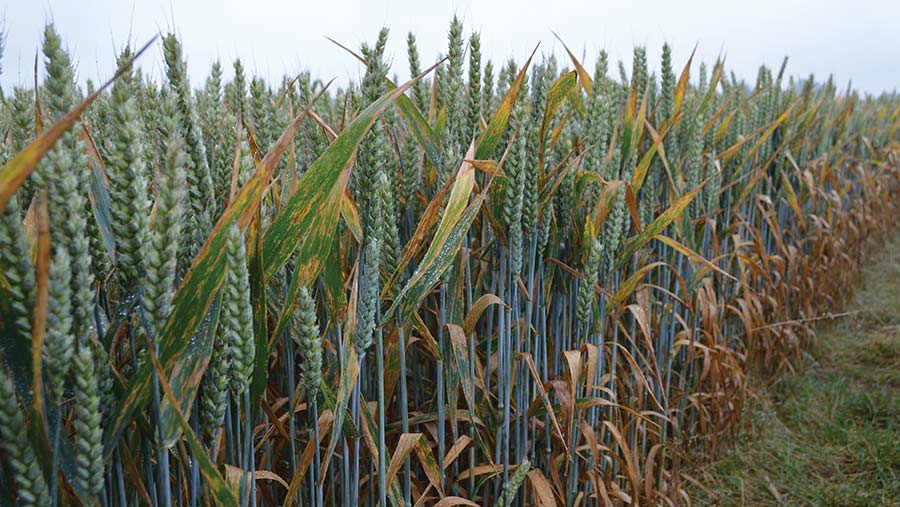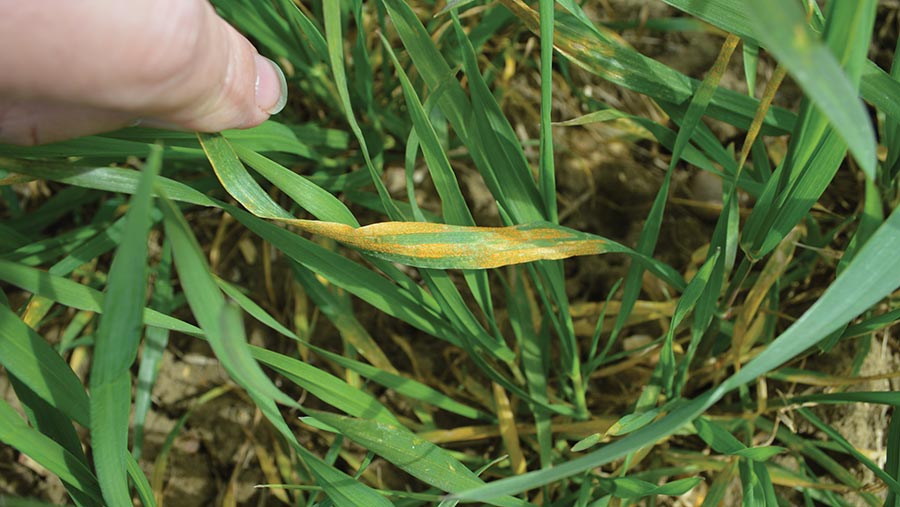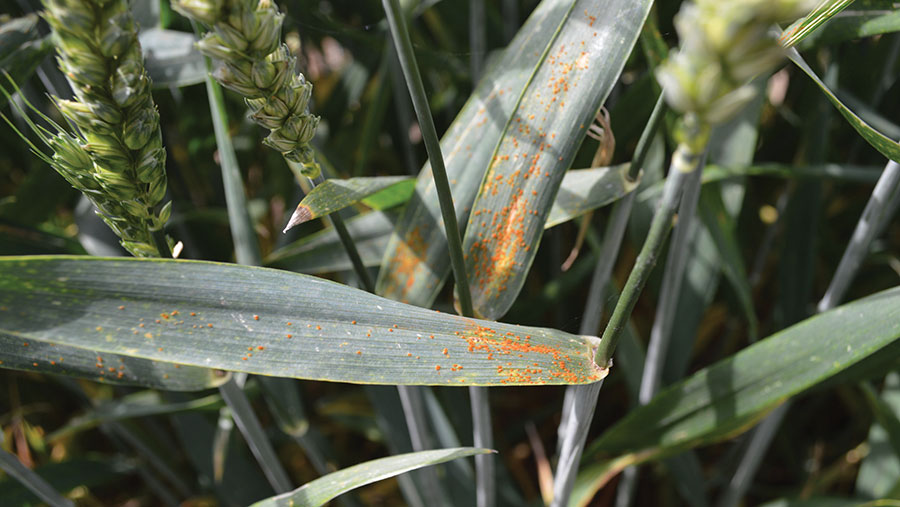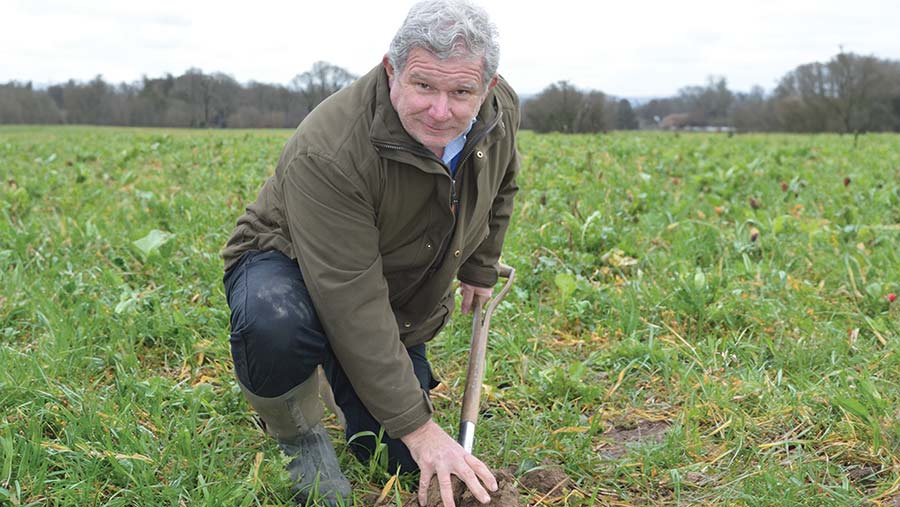Best options for septoria disease control in wheat
 © David Jones
© David Jones The most effective fungicide for controlling septoria in wheat has been found to be Univoq, which is slightly ahead of SDHI-azole combinations, according to independent trials carried out by crop consultant Niab.
The picolinamide-azole combination shows the best curative activity against wheat’s most damaging disease, which gives it an edge over other broad-spectrum fungicides Revystar and new-for-this-spring Vimoy.
Andrew Watson, head of membership technical services and east region agronomist at Niab, says Univoq remains the best eradicant fungicide for this destructive disease, while all three show very good protectant and persistent properties.
See also: What an IPM approach to virus yellows in sugar beet could look like
“Univoq has the slight edge over Revystar and Vimoy. Technically, it is the best product we have for septoria,” he told a recent growers meeting.
Univoq is a mix of the picolinamide fenpicoxamid and azole prothioconazole, Vimoy contains the new SDHI isoflucypram, while Revystar is a mix of the azole mefentrifluconazole and the SDHI fluxapyroxad.
Vimoy will be available for the first time this spring, and will be sold in a twin pack with the azole prothioconazole.
Revystar had its first full season of use in 2021 and Univoq its first full season in 2022.
This ranking ties in with the conclusion from the AHDB Agronomy Conference in December 2023 which pointed out that fenpicoxamid, as a straight, gave the highest level of septoria control, while straights isoflucypram and mefentrifluconazole also gave good activity, especially as protectants.
Rusts

© David Jones
When looking at yellow and brown rusts, Andrew ranks Elatus Era as the most effective protectant fungicide, followed by Vimoy + prothioconazole, Revystar and then Univoq. All four are good products, but all work protectively, he says.
Elatus Era contains the SDHI benzovindiflupyr with prothioconazole, and this SDHI is recognised as a very effective fungicide against rust diseases.
The AHDB agronomy conference concluded that while isoflucypram and mefentrifluconazole gave good yellow rust control, benzovindiflupyr and mixtures Univoq and Revystar were the most effective. It also pointed out that isoflucypram and mefentrifluconazole were both highly active against brown rust.

© David Jones
Tebuconazole
Andrew points out that the best eradicant for both yellow and brown rusts remains the azole tebuconazole, but there are restrictions on how many times it can be used in the season.
This azole will be the main fungicide to use at the early T0 stage in wheat, usually in late March, when yellow rust is the focus rather than septoria, and it can be mixed with a strobilurin for extra rust activity, he says.
If Univoq is reserved for the all-important T2 flag leaf stage, then the choice at the T1 stage in late April is between Ascra, Vimoy/prothioconazole or Revystar with the last two being the most effective. Univoq can only be applied once in a season.
The use of Univoq saw some problems in 2022 as it damaged some farm sprayers, but less damage was reported in 2023 with growers following advice to keep spraying water volumes high and wash out sprayers thoroughly.
“Personally, I have no problem with using Univoq,” says Andrew.
As Univoq contains the picolidamide fenpicoxamid, which has a different site of action on the target fungus to SDHIs or azoles, it can help with resistance management.
On-farm septoria control

Keith Truett © David Jones
Good septoria control is achieved on a Kent farming estate that has used Univoq over the past two seasons on milling wheat in a fungicide programme costing £120-130/ha.
Some 300ha of milling wheat varieties – largely Skyfall and Zyatt – are grown at Morghew Park Estate on the edge of Tenterden in south Kent. While both varieties are susceptible to yellow rust, the fungicide programme kept rusts and septoria at bay.
Keith Truett, regional and on-farm agronomist in the South East for Niab, and the agronomist on the estate, says the product has been the best for septoria control in the two high disease pressure years of 2022 and 2023.
“We have seen very few problems with septoria and both rust diseases,” he says.
The wheat fungicide programme used over the past two seasons has consisted of tebuconazole at T0 on both the yellow rust-susceptible wheat varieties to give early effective control.
At the T1 stage Revystar was used, Univoq at T2 and then at the T3 head spray timing, tebuconazole was applied again to protect from brown rust.
“The programme has done the job and we have tended to change the rates rather than the products,” Keith adds.
Only first wheats are grown on the 800ha estate, drilled between mid-September and mid-October, with other crops including winter and spring beans, oilseed rape, spring oats, spring wheat, vining peas for seed and a small area of potatoes.
Milling winter wheat yields in 2023 were relatively modest at 8-10t/ha, but were hit by barley yellow dwarf virus and the lack of sunlight in June and July to help fill the grains. These wheats usually hit the milling specifications of the breadmakers.
The estate is operated by farm manager Ollie Batehup and assistant Oli Lewis, and is now in its tenth year of no-till across heavy Weald clays, and is seeing the benefit from better structured and draining soils from this direct drilling approach.
All the speakers were attending an AHDB/Niab growers meeting at Morghew Park Estate, Tenterden, in Kent in early February
Key wheat fungicides
- Ascra – SDHIs bixafen and fluopyram plus azole prothioconazole
- Elatus Era – SDHI benzovindiflupyr (Solatenol) plus prothioconazole
- Revystar – SDHI fluxapyroxad (Xemium) plus azole mefentrifluconazole
- Univoq – picolinamide fenpicoxamid (Inatreq) plus prothioconazole
- Vimoy – SDHI isoflucypram (Iblon), used in a twin pack with prothioconazole

